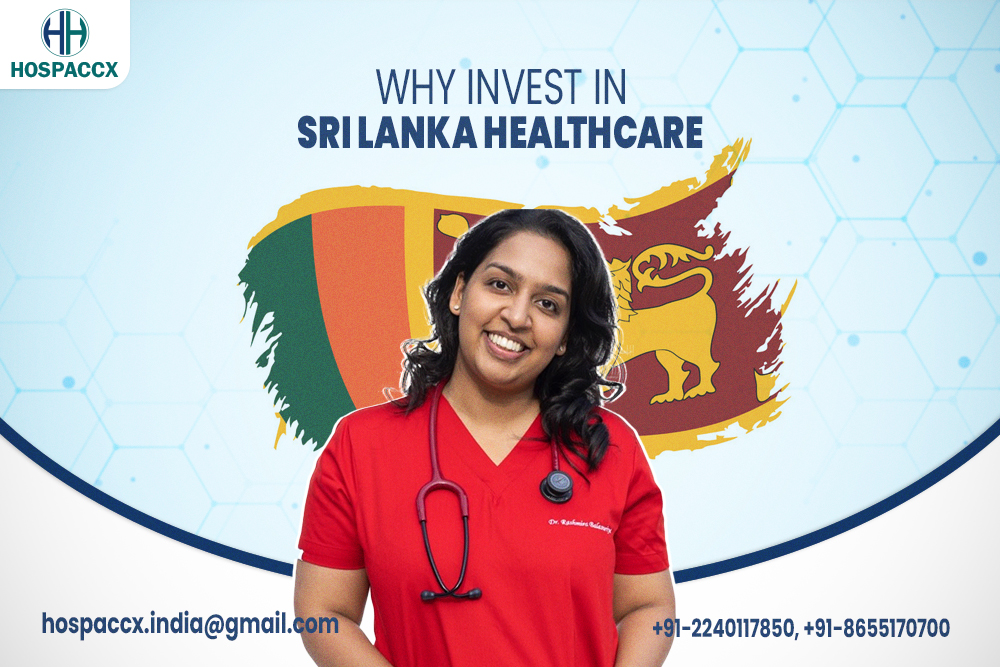WHY INVEST IN SRI LANKA HEALTHCARE
Are you aware of healthcare market scenario of Sri Lanka? Are you planning to invest in healthcare of Sri Lanka? Hospaccx healthcare business consultancy has mapped all the information related to healthcare scenario of Sri Lanka.
If you need a refined market and financial feasibility or any other study related to healthcare is required you can contact Hospaccx Healthcare business consulting Pvt. ltd on Hospaccx.India@gmail.com or you can visit our website on hospaccxconsulting.com
INTRODUCTION
Sri Lanka has a universal health care system that extends free healthcare to all citizens, which has been a national priority. OPD facilities are readily available in public (general) hospitals situated in major towns and cities, with laboratory and radiology facilities common in most.
But most illnesses can be treated in teaching hospitals in Colombo, Colombo South, Colombo North, Kandy / Peradeniya, Galle (Karapitiya Hospital) and Jaffna. All doctors and nurses in the government hospitals are qualified and trained, with some of the most experienced staff working at the teaching hospitals. For emergencies, especially accidents, it is highly recommended to go directly to general hospital accident services as they are equipped with the staff and facilities to handle emergencies.
Despite low levels of health expenditures, Sri Lanka’s health indicators are comparable to more developed countries in the region. The public healthcare system also has long waiting lists for specialized care and advanced procedures. As a result, reliance on private care is increased.
HEALTH EXPENDITURE
Health expenditure in relation to GDP
The ratio of CHE to GDP is estimated as 3.0% in 2015 and 2016, and it fluctuated between 3.0% and 3.7% during 1990–2016 (Figure 3). Both GDP and CHE grew in nominal terms in each year from 1990 to 2016 but the trend in the ratio of current health spending to GDP has not been smooth. It fluctuated between 3.0% and 3.3% pre-2001, and then stabilized at approximately 3.6% till 2006, after which it declined and reached at 3.0% in 2016.
Total Health Expenditure
Total expenditure on health goods and services and capital formation in Sri Lanka in 2015 is estimated as Rs. 369 billion. This represented an increase of Rs. 47 billion over the preceding year, which is a 15% increase in nominal terms. Total expenditure on health in 2016 is provisionally estimated to have been Rs 398 billion. The ratio of total health expenditure to GDP provides an indication of the proportion of overall economic activity contributed by the health sector. It is estimated that total expenditure on health accounted for 3.4% of GDP in 2015, which is a drop from the level of 3.7% of GDP in 1990. In the years 2002–2006 the health to GDP ratio reached its highest levels ever, peaking at around 4%.
SPENDING
Financing the system is also widely considered to be a growing challenge, particularly given Sri Lanka’s ageing population. Despite these and other issues, most local players and market observers consider the health sector to be at the beginning of a period of sustained expansion, driven by rising per capita incomes and growing interest from foreign investors and tourists alike. As of September 2015, congestion at public hospitals coupled with low government investment has led to a pressing need for greater private-sector participation, according to a report published by the international ratings agency Fitch. Indeed, the nation’s private hospitals added new beds at a compound annual growth rate (CAGR) of 21% over the period 2010-14, compared to just 10% at public sector facilities, according to Fitch. The government, meanwhile, is working to ramp up public spending on health care in order to ensure continued provision of high-quality care throughout the state-run system, to implement new technologies across the sector and to prepare for a potential influx of medical tourists.
ORGANISATION
According to data produced by the Central Bank of Sri Lanka (CBSL) and the World Bank, by the end of 2014 the public sector accounted for around 73% of the 750 hospitals and 93% of the 75,000 beds available. However, new facilities and beds are being added in the private sector system at a significantly faster rate. Although the private sector foresees continued growth, according to a 2015 report by the IHP, the quality of care provided in public health facilities was generally higher, despite the significantly lower cost of care.
The public system is organized into three tiers. Primary care facilities include central dispensaries, small-scale rural hospitals, clinics and peripheral sites. The secondary care segment comprises base, district and provincial hospitals. Lastly, specialized hospitals and teaching hospitals qualify as tertiary care institutions. Preventative health care education and promotion is managed by 310 regional health units, called Medical Office of Health areas, which cover the entire country and are largely overseen by Sri Lanka’s provincial councils.
The largest public sector hospital is the National Hospital of Sri Lanka (NHSL), which, with around 3300 beds, is among the largest hospitals in South Asia. In addition to the NHSL, the state operates 20 teaching hospitals, three provincial general hospitals, 18 district general hospitals, five specialist-care hospitals, more than 100 additional smaller hospitals and more than 470 primary medical care units across the country, according to MoHNIM data. In 2011 public health care facilities reported 49m outpatient visits and upwards of 5.5m inpatient admissions, compared to 4.7m and 270,000, respectively, at private sector facilities, according to the World Bank.
MEDICAL TOURISM
Sri Lanka’s private sector hospitals have been growing at double digit rates due to the demand for higher quality services on the back of the country’s rising income levels. This has been the main catalyst for the industry’s growth, although medical tourism has certainly been a supporting factor as well. The government has recognized the need for Sri Lanka to develop a high quality private healthcare sector, which bodes well for the country’s potential to attract increased medical tourists in the future. Sri Lanka’s medical tourism industry has ample room for growth considering that the majority of its current medical tourists mainly come from surrounding South Asian countries. However, the top five source countries for tourists in Sri
Lanka include India, China, the UK, Germany and France, which all represent markets that are potentially highly lucrative. Sri Lanka received 2.1 million tourists last year compared to only around 450,000 in 2015, as the country has seen substantial improvements in its tourism image following the end of the country’s civil war. One of the main benefits of Sri Lanka’s medical tourism industry includes that its costs are lower compared to that of other emerging markets such as Thailand and Malaysia, which is why medical tourists from less developed countries in
South Asia favors Sri Lanka as a low cost option.
POLICY IMPLICATIONS
- Sri Lanka’s rapidly changing demographics will present major health security challenges. The government must assume a greater role in healthcare because the traditional familial support system is no longer capable of adequately providing for the needs of the fast-growing elderly population.
- In order to combat the rising incidence of non-communicable diseases, Sri Lanka will need to enhance existing health infrastructure and effectively implement prevention programs.
- Unlike with non-communicable diseases, the Sri Lankan government comes under direct public criticism whenever there is an eruption of a communicable disease. Therefore, the government must be constantly prepared for potential outbreaks.
- Finding a peaceful political solution to the country’s still-unresolved ethnic conflict will create the possibility of diverting a portion of defense expenditures to health and education.
PLANNING FOR GROWTH
In recent years the MoHNIM has worked with international advisory organizations to improve the quality of care in the public system. The state is currently at the tail end of implementing a decade-long development plan – the Health Sector Master Plan 2007-16 – which was largely structured around the health targets of the UN’s Millennium Development Goals (MDGs).
According to the WHO, the plan was designed to encourage further growth through increased investment in infrastructure, achieve more equitable development through assistance to lagging regions and strengthen the delivery of public services.
Nonetheless, over the past two decades Sri Lanka’s health care landscape has changed considerably. NCDs are now the primary area of focus for much of the country’s medical establishment. The government addressed this issue by passing the NCD Policy and Strategic Framework in 2009, which lays out a roadmap for boosting awareness of NCDs and encouraging the population to make changes to combat lifestyle-related diseases. Another relatively recent change has been the state’s effort to implement new technological systems across the public health care system, with several pilot projects currently under way in this area.
CONCLUSION
Considering the state’s ongoing efforts to shore up service provision and ensure the cost of care remains low, the public health care sector is likely to continue improving. The state has achieved a remarkably high level of care with very little expenditure. Meanwhile, the private sector has made big strides recently, with companies opening high-end hospitals and other specialized facilities at a rapid pace. Medical tourism also holds the potential to boost revenues considerably over the next decade, and the state’s efforts to encourage domestic pharmaceutical manufacturing bode well for private investors.
Going with this project will give us the benefit, giving the facilities in terms of healthcare and it will be beneficial for the promoter.
It is the superficial and macro level study for more details kindly contact Hospaccx Healthcare business consulting Pvt. ltd on Hospaccx.India@gmail.com or you can visit our website at hospaccxconsulting.com
Related Team Members










